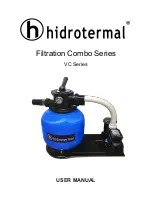
REVERSE OSMOSIS SYSTEMS RO 4... /E /EL - INSTRUCTIONS MANUAL
s.r.l.Milano - ITALY
Page 18 of 25
ro4e_mi-r10.doc -
r. 10
6.
Starting-up and adjustments
At the starting-up of the system, when the system is re-started after a long non-working
period, and after a cleaning operation, the membranes are filled with preservative or detergent
chemical.
Hence, in any cases, it is required to remove completely the preservative or detergent from
the membranes before that treated water can be used.
The operations are made as follows : (see "
DIAGRAM OF THE SYSTEM"
)
•
be sure that the power switch of power control panel
QE
is OFF (main switch on “0”)
•
connect temporarily the auxiliary fitting R to the drain
•
divert, temporarily also the permeate line to the
drain, by turning the 3-way valve V3 on cleaning
position, (the direction of the flow towards the fitting
R, check the direction with the symbol marked on the
lever of 3-ways valves).
•
open completely the needle regulation valve
VS
•
close completely the needle regulation valve
VR
•
open slowly the water inlet valve of the system. In order to make easy the filling of the
filter(s)
F
, open slowly the air release screw or the valve placed on the top side of the
filter(s)
•
switch ON the main power of
QE
control board
(
turning
on
"1" position), and switch the
mode selector of the pump on "MAN" position; the RO unit will start to work.
•
after several minutes of working (
check carefully that there is required minimum
pressure of water inlet, by the pressure gauges M1 and M2: the minimum pressure
control is out of working when the mode selector is on “MAN” position
), the service
flow rates can be checked and adjusted.
•
adjust the needle valve
VS,
mounted along the the drain line of the membranes, in order
that the flow rate of permeate (flow meter
F1)
meets the technical data of the system. The
value of pressure shown on pressure gauge
M4,
after the adjustment of
VS
valve, is the
normal working pressure of the system according to the available raw water quality
(chemical composition, temperature, etc.)
An adjustable recirculating system is available, in order to reduce the quantity of
concentrated
(drain) water and/or reduce the working pressure; proceed as follows :
•
adjust the needle valve
VR
to recirculate part of concentrated water in order to reduce the
flow rate of water actually carried to drain. The adjustment of the valve
VR
causes also
the modification of the working pressure, hence a new adjustment of valve
VS
is required,
until both values pressure/flow rate are the desired ones.
•
The valve VRP, mounted downstream of the pump P, allows to throttle the forcing line of
the pump, in order to reduce both the pressure and the flow rate on membranes.
This feature can be useful for the system to run at low pressure, without recirculationg or
draining a too high flow of water.
A “too high flow” means the one that causes a pressure drop, across the membranes,
over than 3 bars (300 kPa) for each housing (difference of pressure between M3-M5 and
M5-M4). This needing happens more often with new membranes, when they produce the
max flow.
















































